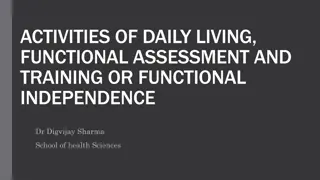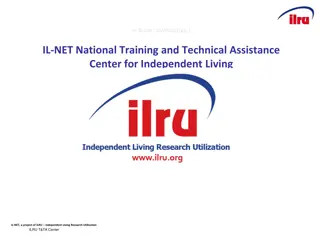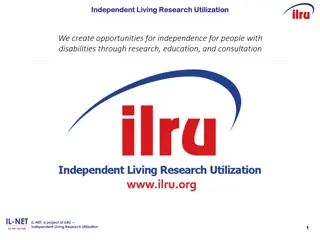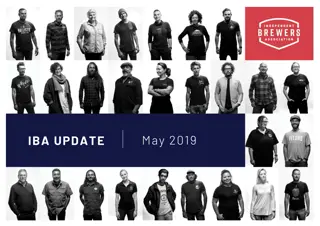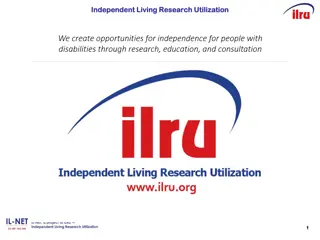ADL and IADL Activities for Independent Living
The Activities of Daily Living (ADL) and Instrumental Activities of Daily Living (IADL) are essential for independent living. ADL includes basic tasks like grooming and eating, while IADL involves more complex activities such as managing finances and medications. Studies have shown differences in ADL-disability rates between genders and the impact of physical activity on reducing disability. Learn about the types of ADL, including both basic and instrumental activities, and their importance for maintaining independence in daily life.
Download Presentation

Please find below an Image/Link to download the presentation.
The content on the website is provided AS IS for your information and personal use only. It may not be sold, licensed, or shared on other websites without obtaining consent from the author.If you encounter any issues during the download, it is possible that the publisher has removed the file from their server.
You are allowed to download the files provided on this website for personal or commercial use, subject to the condition that they are used lawfully. All files are the property of their respective owners.
The content on the website is provided AS IS for your information and personal use only. It may not be sold, licensed, or shared on other websites without obtaining consent from the author.
E N D
Presentation Transcript
The Activities of Daily Living are a series of basic activities performed by individuals on a daily basis necessary for independent living at home or in the community. The term activities of daily living was first coined by Sidney Katz in 1950. [1] ADL is used as an indicator of a person s functional status. The inability to perform ADLs results in the dependence of other individuals or mechanical devices. The inability to accomplish essential activities of daily living may lead to unsafe conditions and poor quality of life.
In 2011, the United States National Health Interview Survey determined that 20.7% of adults aged 85 or older, 7% of those aged 75 to 84, and 3.4% of those aged 65 to 74 needed help withADLs.[2]
A study from The Netherlands conducted between 1990 and 1999, examined 1129 persons 55 years and older, who were ADL-disability free at baseline. At a 6-year follow-up, 26.7% showed ADL-disability. The incidence of ADL-disability was higher in women (33.2%) than in men (19.7%). Women had also a higher proportion of severe disability.[3]
The incidence rate for ADL-disability was also higher in women than in men in a study from Brazil. They examined persons 60 years and older who had no difficulties in ADL at baseline in 2000 and, again, at follow-up 6 years later. The incidence for women were 42.4/1000 person-years and for men 17.5/1000 person-years.[4] A cohort study from US examined 787 persons living in senior housing facilities with no ADL-disability at baseline. After 2.6 years they found that persons who reported 2.33 hours of physical activity per week had 16% less ADL-disability compared with persons that reported no physical activity.[5]
TYPES OF ADL The activities of daily living are classified into basic ADLs and Instrumental Activities of Daily Living (IADLs). The basic ADLs (BADL) or physical ADLs are those skills required to manage one s basic physical needs, including personal hygiene or grooming, dressing, toileting, transferring or ambulating, and eating. The Instrumental Activities of Daily Living (IADLs) include more complex activities related to the ability to live independently in the community. This would include activities such as e.g., managing finances and medications, food preparation, housekeeping, laundry.
BASICADLs The basicADL include the following categories: Ambulating: The extent of an individual s ability to move from one position to another and walk independently. Feeding: The ability of a person to feed oneself. Dressing: The ability to select appropriate clothes and to put the clothes on. Personal hygiene: The ability to bathe and groom oneself and maintain dental hygiene, nail, and hair care. Continence: The ability to control bladder and bowel function Toileting: The ability to get to and from the toilet, using it appropriately, and cleaning oneself.
INSTRUMENTALADLs The instrumental ADLs are those that require more complex thinking skills, including organizational skills. Transportation and shopping: Ability to procure groceries, attend events Managing transportation, either via driving or by organizing other means of transport. Managing finances: This includes the ability to pay bills and managing financial assets. Shopping and meal preparation, i.e., everything required to get a meal on the table. It also covers shopping for clothing and other items required for daily life.
Housecleaning and home maintenance. Cleaning kitchens after eating, maintaining living areas reasonably clean and tidy, and keeping up with home maintenance. Managing communication with others: The ability to manage telephone and mail. Managing medications: Ability to obtain medications and taking them as directed.
Causes for limitations in ADLs Aging is a natural process that may present a decline in the functional status of patients and is a common cause of subsequent loss ofADLs. Musculoskeletal, neurological, circulatory, or sensory conditions can lead to decreased physical function leading to impairment inADLs. A cognitive or mental decline can also lead to impaired ADL's. Severe cognitive fluctuations in dementia patients have a significant association with impaired engagement in activities of daily living that negatively affect the quality of life.
Social isolation can lead to impairment in instrumental activities of daily living. Other factors such as side effects of medications, social isolation, or the patient's home environment can influence the ability to performADLs. Hospitalization and acute illnesses have also been associated with a decline inADLs
MEASUREMENTS OF ADLs The most frequently used checklists are the Katz Index of Independence in Activities of Daily Living and the Lawton Instrumental Activities of Daily Living (IADL) Scale.
KATZ INDEX OF INDEPENDENCE IN ACTIVITIES OF DAILY LIVING The Katz scale assesses the basic activities of daily living but does not assess more advanced activities of daily living. The Katz ADL scale is sensitive to changes in declining health status, but its limitations include the limited in its ability to measure small elements of change seen in the rehabilitation of older adults. However, it is very useful in creating a common language about patient function for healthcare providers involved in the overall care and discharge planning.
WHY: Normal aging changes and health problems frequently show themselves as declines in the functional status of older adults. Decline may place the older adult on a spiral of iatrogenesis leading to further health problems. One of the best ways to evaluate the health status of older adults is through functional assessment which provides objective data that may indicate future decline or improvement in health status. TARGET POPULATION: The instrument is most effectively used among older adults in a variety of care settings, when baseline measurements taken, when the client is well, are compared to periodic or subsequent measures.
The Katz Index of Independence in Activities of Daily Living, commonly referred to as the Katz ADL, is the most appropriate instrument to assess functional status as a measurement of the client s ability to perform activities of daily living independently. Clinicians typically use the tool to detect problems in performing activities of daily living and to plan care accordingly. The Index ranks adequacy of performance in the six functions of bathing, dressing, toileting, transferring, continence, and feeding. Clients are scored yes/no for independence in each of the six functions. A score of 6 indicates full function, 4 indicates moderate impairment, and 2 or less indicates severe functional impairment.
VALIDITY AND RELIABILITY: In the thirty-five years since the instrument has been developed, it has been modified and simplified and different approaches to scoring have been used. However, it has consistently demonstrated its utility in evaluating functional status in the elderly population. Although no formal reliability and validity reports could be found in the literature, the tool is used extensively as a flag signaling functional capabilities of older adults in clinical and home environments.
STRENGTHS AND LIMITATIONS: The Katz ADL Index assesses basic activities of daily living. It does not assess more advanced activities of daily living. Katz developed another scale for instrumental activities of daily living such as heavy housework, shopping, managing finances and telephoning. Although the Katz ADL Index is sensitive to changes in declining health status, it is limited in its ability to measure small increments of change seen in the rehabilitation of older adults. A full comprehensive geriatric assessment should follow when appropriate. The Katz ADL Index is very useful in creating a common language about patient function for all practitioners involved in overall care planning and discharge planning.
LAWTON-BRODY INSTRUMENTALACTIVITIES OF DAILY LIVING SCALE (I.A.D.L.) The Lawton Instrumental Activities of Daily Living (IADL) Scale is used to evaluate independent living skills (Lawton & Brody, 1969). The instrument is most useful for identifying how a person is functioning and identifying improvement or deterioration over time. The scale measures eight domains of function, including food preparation, housekeeping, laundering. Individuals are scored according to their highest level of functioning in that category.
A summary score ranges from 0 (low function, dependent) to 8 (high function, independent). The scale is easy to administer assessment instrument that provides self-reported information about functional skills necessary to live in the community. The limitations of this scale are that it is a self-administered test rather than the actual demonstration of the functional task. This may lead either to over-estimation or under-estimation of the ability to perform the activity.
WHY: The assessment of functional status is critical when caring for older adults. Normal aging changes, acute illness, worsening chronic illness, and hospitalization can contribute to a decline in the ability to perform tasks necessary to live independently in the community. The information from a functional assessment can provide objective data to assist with targeting individualized rehabilitation needs or to plan for specific in home services such as meal preparation, nursing care, home-maker services, personal care, or continuous supervision. A functional assessment can also assist the clinician to focus on the person s baseline capabilities, facilitating early recognition of changes that may signify a need either for additional resources or for a medical work-up (Gallo, 2006).
TARGET POPULATION: This instrument is intended to be used among older adults, and can be used in community or hospital settings. The instrument is not useful for institutionalized older adults. It can be used as a baseline assessment tool and to compare baseline function to periodic assessments. The Lawton Instrumental Activities of Daily Living Scale (IADL) is an appropriate instrument to assess independent living skills (Lawton & Brody, 1969). These skills are considered more complex than the basic activities of daily living as measured by the Katz Index ofADLs.
The instrument is most useful for identifying how a person is functioning at the present time, and to identify improvement or deterioration over time. There are eight domains of function measured with the Lawton IADL scale. Women are scored on all 8 areas of function; historically, for men, the areas of food preparation, housekeeping, laundering are excluded. Clients are scored according to their highest level of functioning in that category. A summary score ranges from 0 (low function, dependent) to 8 (high function, independent) for women, and 0 through 5 for men.
VALIDITY AND RELIABILITY: Few studies have been performed to test the Lawton IADL scale psychometric properties. The Lawton IADL Scale was originally tested concurrently with the Physical Self-Maintenance Scale (PSMS). Reliability was established with twelve subjects interviewed by one interviewer with the second rater present but not participating in the interview process. Inter-rater reliability was established at .85.
The validity of the Lawton IADL was tested by determining the correlation of the Lawton IADL with four scales that measured domains of functional status, the Physical Classification (6-point rating of physical health), Mental Status Questionnaire (10-point test of orientation and memory), Behavior and Adjustment rating scales (4-6-point measure of intellectual, person, behavioral and social adjustment), and the PSMS (6-item ADLs). A total of 180 research subjects participated in the study, however, few received all five evaluations. All correlations were significant at the .01 or .05 level. To avoid potential gender bias at the time the instrument was developed, specific items were omitted for men. This assessment instrument is widely used both in research and in clinical practice
STRENGTHS AND LIMITATIONS: The Lawton IADL is an easy to administer assessment instrument that provides self-reported information about functional skills necessary to live in the community. Administration time is 10- 15 minutes. Limitations of the instrument can include the self-report or surrogate report method of administration rather than a demonstration of the functional task. This may lead either to over-estimation or under-estimation of ability. In addition, the instrument may not be sensitive to small, incremental changes in function. FOLLOW-UP: The identification of new disabilities in these functional domains warrants intervention and further assessment to prevent ongoing decline and to promote safe living conditions for older adults.
CLINICALSIGNIFICANCE Assessment of ADLs is an important aspect of routine patient assessment and assists healthcare providers in assessing the patient s status, plan, and intervene appropriately. A provider needs to address a patient s general medical condition when determining their level of accomplishing functional capabilities that otherwise ensure independent living and personal care. An ADL assessment helps determine whether a patient may require further rehabilitation or assistance at home or if a skilled nursing or long-term care facility would be a safer environment for the patient.
ROLE OFTEAM WORK All interprofessional healthcare team members, including clinicians, nurses, physical therapists, and occupational therapists, should collaborate to assess the functionality of patients before discharge. Patients who are unable to perform activities of daily living may require further rehabilitation or assistance at home. The inability to dress or toilet can lead to poor quality of life. Difficulty in eating independently can lead to poor nutrition, dehydration, and further weakness.
Appropriate referrals to OT, PT, and dieticians should be considered. Assessment of functionality should become routine practice for all patients as it can affect people of all ages. An inter professional team communicating and collaborating will provide the best patient evaluation and discharge with good follow-up care. The nursing staff should report to the medical team concerns in regards to patients unable to completeADLs. The inter professional clinical team assists in directing the nursing home health and social work coordinators to make sure patients receive the care they need. The home health nursing staff needs to provide ongoing monitoring and reporting back to the clinical team should an increase in deficiency ofADLs occur.
SUMMARY Activities of daily living (ADLs) are essential and routine tasks that most young, healthy individuals can perform without assistance. The inability to accomplish essential activities of daily living may lead to unsafe conditions and poor quality of life.
ANY QUERIES
REFERENCES 1. Katz S. Assessing self-maintenance: activities of daily living, mobility, and instrumental activities of daily living. JAm Geriatr Soc. 1983 2. Adams PF, Kirzinger WK, Martinez ME. Summary health statistics for the u.s. Population: national health interview survey, 2011. Vital Health Stat 10. 2012 3. Tas U, Verhagen AP, Bierma-Zeinstra SM, Hofman A, Odding E, Pols HA et al. (2007) Incidence and risk factors of disability in the elderly: The Rotterdam study. 4. Alexandre Tda S, Corona LP, Nunes DP, Santos JL, Duarte YA, Lebrao ML (2012) Gender differences in incidence and determinants of disability in activities of daily living among elderly individuals: SABE study. 5. Shah RC, Buchman AS, Leurgans S, Boyle PA, Bennett DA (2012) Association of total daily physical activity with disability in community-dwelling older persons: A prospective cohort study.
THANK YOU




